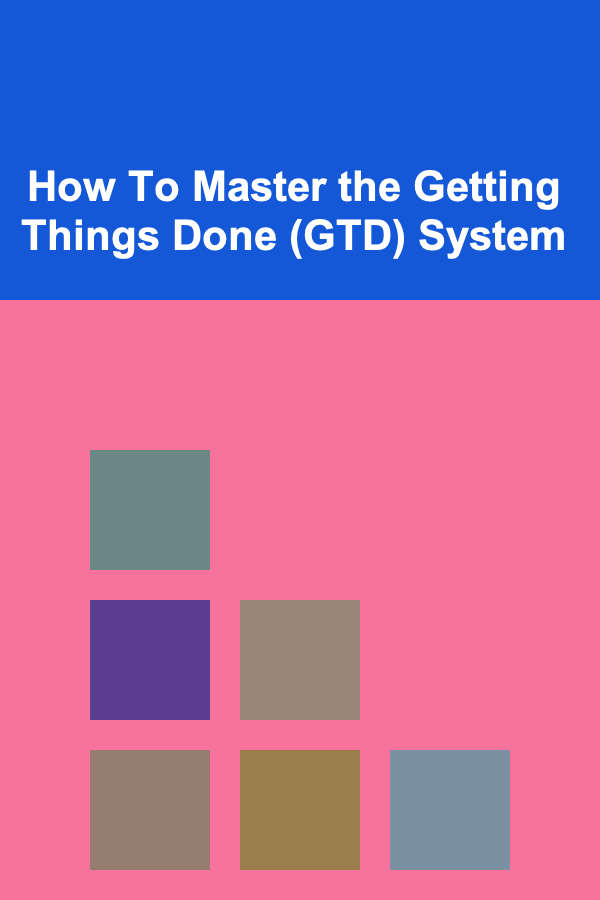
How To Master the Getting Things Done (GTD) System
ebook include PDF & Audio bundle (Micro Guide)
$12.99$7.99
Limited Time Offer! Order within the next:

The Getting Things Done (GTD) system, created by productivity expert David Allen, is one of the most popular methods for managing tasks, projects, and personal responsibilities. It is designed to help individuals clear their minds, organize their workflows, and enhance their productivity. The GTD system has transformed how many approach task management by providing a structured, comprehensive framework for capturing, organizing, and completing tasks.
Mastering the GTD system can significantly boost productivity, reduce stress, and improve focus. However, like any system, it requires practice, patience, and consistency. This article will explore the fundamental principles of GTD and offer strategies to help you master the system and integrate it into your daily life effectively.
What Is the Getting Things Done (GTD) System?
The Getting Things Done system is based on the premise that the mind is not designed to remember every task or commitment, and as a result, our mental space becomes cluttered. GTD aims to declutter the mind by creating a reliable system where tasks and responsibilities are captured, organized, and processed efficiently. The result is a clear mind and a system that helps individuals stay on top of their work and life with less stress.
David Allen's approach revolves around five key steps:
- Capture: Collect everything that requires your attention in an external system.
- Clarify: Process what each item means and decide on the next actions.
- Organize: Categorize and arrange tasks and projects based on priority and context.
- Reflect: Regularly review your tasks and projects to ensure you are on track.
- Engage: Focus on completing tasks that align with your current context and priorities.
By following these steps, individuals can take control of their tasks and create a sense of order in their lives. Let's explore each of these steps in more detail to understand how they can be mastered.
Step 1: Capture -- Collect Everything
The first step in GTD is to capture everything that is on your mind or that demands your attention. This can include work tasks, personal responsibilities, appointments, ideas, or anything that may be weighing you down mentally. Capturing involves gathering all of these into an external system, such as a notebook, digital app, or any tool that works best for you.
How to Capture Effectively
- Use a Trusted Tool: The most important aspect of capturing is choosing a tool that you trust and can easily access. Whether it's a physical notebook, a digital app like Todoist or Evernote, or a voice recorder, the tool should allow you to capture thoughts quickly without interrupting your workflow.
- Capture Everything: Don't filter what to capture. If it pops into your mind, capture it immediately. This might seem like a lot, but this step ensures that nothing slips through the cracks, and you are not distracted by an incomplete mental to-do list.
- Have Multiple Capture Channels: Make sure you have several ways to capture ideas. For example, if you're out running errands and an idea comes to mind, use a voice memo or a notes app. If you're at your desk, write it down in your notebook or task manager.
Benefits of Capturing
- Clears Mental Clutter: By capturing everything, you release mental energy that would otherwise be spent remembering tasks.
- Improves Focus: When you know you have a reliable system to hold all of your tasks, you can focus more on the task at hand, rather than constantly worrying about things you might forget.
- Reduces Stress: By offloading your to-dos, you remove the burden of trying to remember everything, which reduces anxiety and mental overload.
Step 2: Clarify -- Decide What Each Item Means
Once you've captured everything, the next step is to clarify. This step involves reviewing each item on your list and determining what needs to be done next. It's important to break down each item into actionable steps or decide if it can be discarded or delegated.
How to Clarify
- Ask, "What is this?": Look at each captured item and ask yourself, "What does this mean?" For example, an item like "Call John about the meeting" needs to be clarified by deciding on the next action, such as "Find John's phone number" or "Send John an email to confirm the meeting time."
- Determine if It's Actionable: If it's not actionable, decide what to do with it. Can you delete it? Can you archive it for future reference? If it is actionable, decide on the next step.
- Break Tasks Down: If a task seems overwhelming, break it down into smaller, manageable steps. This reduces procrastination and gives you a clear action plan.
Benefits of Clarifying
- Prevents Overwhelm: By deciding what to do with each item, you break things down into manageable actions, preventing feelings of overwhelm.
- Clears Ambiguity: Clarifying ensures that everything on your list is clear and actionable, which prevents procrastination caused by uncertainty.
- Improves Decision Making: The clarification step helps you practice decision-making skills, which can improve your ability to prioritize tasks effectively.
Step 3: Organize -- Categorize and Prioritize
Once you've clarified each item, the next step is to organize your tasks. This involves grouping tasks by context, priority, or category, making it easier to know what to work on in any given situation.
How to Organize
- Use Contexts: Contexts refer to the environments or tools required to complete a task. For example, you may have contexts like "Home," "Work," or "Phone." Organizing tasks by context allows you to focus on what you can do based on where you are and what resources you have available.
- Prioritize: Organize tasks by urgency and importance. You can use methods like the Eisenhower Matrix (dividing tasks into urgent/important, non-urgent/important, urgent/not important, and non-urgent/not important) to help prioritize.
- Use Projects: A "project" in GTD refers to any task that requires more than one action step. Projects should be tracked separately from simple tasks, and you can organize them by categories such as work projects, personal projects, or long-term goals.
- Create Next Action Lists: Make a list of the very next physical action required to move forward with a project. This ensures that you always know exactly what to do next without needing to think too much.
Benefits of Organizing
- Focuses Your Efforts: Organizing tasks helps you focus on what needs to be done first and allows you to work smarter, not harder.
- Improves Efficiency: With everything categorized and prioritized, you don't waste time deciding what to do next, as the system already tells you.
- Reduces Stress: A well-organized system reduces mental clutter and allows you to trust that everything is accounted for, leading to greater peace of mind.
Step 4: Reflect -- Regularly Review Your System
To keep your system working effectively, you need to reflect regularly. This step ensures that you are on track and that everything is up to date. Reflection involves reviewing your tasks and projects, ensuring nothing falls through the cracks, and adjusting your plan as needed.
How to Reflect
- Conduct a Weekly Review: The most important time to reflect is during your weekly review. This is where you assess your progress, look at what tasks need to be done, and decide what to focus on for the upcoming week. A weekly review allows you to adjust priorities and make sure you're aligned with your long-term goals.
- Review Your Project List: During your weekly review, check all of your active projects and make sure you know the next action for each one. If there are any tasks that need to be added or re-prioritized, this is the time to do it.
- Update Your Calendar: Reflecting also means updating your calendar. Make sure you are prepared for upcoming deadlines, meetings, and events.
Benefits of Reflecting
- Keeps You on Track: Regularly reviewing your tasks and projects ensures that you are consistently working on the right things and not getting sidetracked.
- Improves Long-Term Planning: Reflection helps you align your day-to-day tasks with your bigger goals, ensuring that you are making progress on what truly matters.
- Increases Accountability: By reviewing your system and updating it, you hold yourself accountable to your own commitments and deadlines.
Step 5: Engage -- Take Action
The final step in the GTD system is engage. This is the moment where you execute on your plans and focus on completing tasks that align with your current context and priorities.
How to Engage
- Focus on Context: Look at the tasks in your current context and choose what to do next based on where you are and what you can do.
- Avoid Multitasking: Focus on one task at a time. Multitasking can reduce your efficiency and quality of work.
- Use the Two-Minute Rule: If a task will take less than two minutes to complete, do it immediately. This keeps small tasks from piling up.
Benefits of Engaging
- Increased Productivity: By focusing on the right tasks and avoiding distractions, you will complete more work in less time.
- Sense of Accomplishment: Completing tasks gives you a sense of accomplishment, which boosts motivation and morale.
- Reduced Procrastination: The GTD system helps you take immediate action on tasks, which reduces procrastination and builds momentum.
Conclusion: Mastering GTD for Better Productivity
Mastering the Getting Things Done (GTD) system requires commitment and practice. By following the five key steps---capture, clarify, organize, reflect, and engage---you can reduce mental clutter, improve productivity, and feel more in control of your work and life. The key to success with GTD is consistency: regular reviews, constant refinement of your system, and focusing on the next action.
The GTD system is not just about getting more done; it's about getting the right things done. It's about clearing the mental clutter, focusing on priorities, and reducing stress. As you master GTD, you'll find yourself more organized, more focused, and less overwhelmed by the demands of everyday life.
Reading More From Our Other Websites
- [Star Gazing Tip 101] From Ground to Galaxy: How Drones Enhance Amateur Astronomy
- [Screen Printing Tip 101] Essential Screen Printing Equipment for Beginners: A Complete Starter Kit Guide
- [Personal Care Tips 101] How to Create a Sustainable Fitness Routine
- [Home Family Activity 101] How to Build a Family Movie Theater Experience at Home
- [Home Budget Decorating 101] How to Create a Cozy Atmosphere with Lighting
- [Organization Tip 101] Converting to LED Recessed Lighting: Cost and Energy Savings Explained
- [Organization Tip 101] Why Creating Zones in Your Home Enhances Flow
- [Whitewater Rafting Tip 101] Flow State on the River: How Rafting Amplifies Mindful Presence
- [Personal Care Tips 101] How to Choose the Right Blush Brush for Different Textures
- [Home Renovating 101] How to Use Digital Tools for Effective Renovation Project Management and Tracking

How to Build a Flexible Riding Schedule for Extra Income
Read More
How to Create the Perfect Party Atmosphere with Lighting
Read More
How to Use Customer Feedback from Returns and Refunds to Improve Your Dropshipping Store
Read More
The Industrial Engineer's Toolkit: Essential Techniques for Process Improvement
Read More
How To Master Emotional Regulation
Read More
How to Budget for Travel on a Shoestring Budget
Read MoreOther Products

How to Build a Flexible Riding Schedule for Extra Income
Read More
How to Create the Perfect Party Atmosphere with Lighting
Read More
How to Use Customer Feedback from Returns and Refunds to Improve Your Dropshipping Store
Read More
The Industrial Engineer's Toolkit: Essential Techniques for Process Improvement
Read More
How To Master Emotional Regulation
Read More